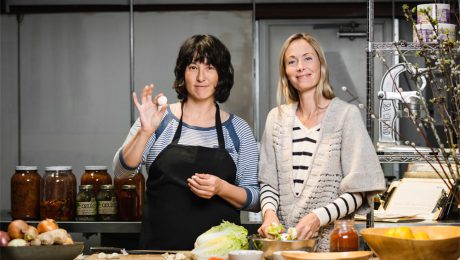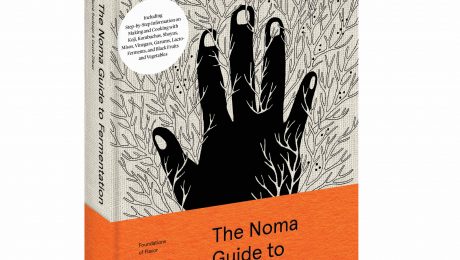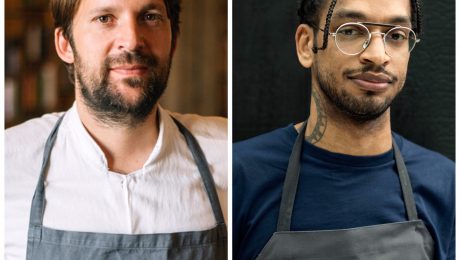Q&A with Jared Schwartz, Operations for Farm Ferments & Poor Devil Pepper Co.
Jared Schwartz was in art school when the quality of the American food culture struck a nerve in him. He worked in restaurant kitchens while studying photography in Boston and was disturbed by the mindlessness of the food industry. No one was paying attention to the food they were eating, from the ingredients they were consuming to the source of the food.
“I started looking at the most traditional aspects in the food world, the way Japanese, Chinese and Vietnamese people eat. Everything comes back to salt and fermentation,” says Jared. “It creatively made me think what can we do in fermentation that’s not around the standard. We have this standard – but what’s the future of it?”
Jared moved to update New York and began fermenting full-time. Heavily involved in multiple businesses, Jared is growing five local food brands – and adding more. Today, he is the director of operations and innovation at Farm Ferments (a fermentation hub in New York’s Hudson Valley), Hawthorne Valley Ferments (the fermented vegetable line of Hawthorne Valley biodynamic farm), Poor Devil Pepper Co. (the fermented hot sauce company started by Jared and wife Laura Webster) and Sauerkraut Seth’s (a raw sauerkraut). Hawthorne Valley Ferments, Poor Devil Pepper Co. and Sauerkraut Seth’s source almost all ingredients from organic, regenerative farms in New York state and the northeast.
“With Farm Ferments, we’re trying to create that middle ground for fermentation processors instead of becoming a monster powerhouse. We want to include smaller brands in that,” Jared says.
“With Whitethorne, we’re trying to create that middle ground for fermentation processors instead of becoming a monster powerhouse. We want to include smaller brands in that,” Jared says.
Though he began Poor Devil Pepper Co., he loves seeing more fermented sauce and dressing labels join the industry. More brands means more customers learning about fermentation. He adds: “If there’s only one fermented hot sauce or one fermented salad dressing in a case, people are like ‘Why buy it?’ It’s not going to move. There’s strength in community.”
Below Jared, a board member of the Fermentation Association, discusses successfully launching multiple fermented food brands, the importance of collaboration in the fermentation industry and how brands can support the farmers that source their food.
Q: Tell me about Hawthorne Valley Ferments, you’ve helped triple production.
When I started about 7 years ago, I started pushing the envelope in terms of production capabilities and sort of recipe fine-tuning, and we’ve started to grow progressively.
Q: What do you mean by pushing the envelope?
In terms of getting to the nitty-gritty of ferment time, turn overs, the farms were working with and sort of diving into the effective quality of different salt types. We’re finding the sweet spot that kind of creates a smoother cog of the fermentation system because I feel like every company is doing the same thing, but they all kind of have their own twists on it that takes a bit to come into.
Q: What are some of the twists?
Trade secrets. But like their own salt types, their own weight systems, their own ferment times. And a lot of it is environmentally related. Out west, they’re going to do things different than what we’re doing out east because of yeasts in the air. Northern California wine country is going to be battling yeasts off grapes where we’re dealing with different frost times on the east coast.
Q: When did you and your wife start Poor Devil Pepper Company?
A: Poor Devil started in 2014 working after hours at Hawthorne Valley Ferments. I started making sauerkraut and ferments at Hawthorne Valley and, at the same time, started taking the logic of basic sauerkrauts and kimchis and turning it into salad dressings, hot sauces, everything under the sun. We started in 5-gallon buckets and just grew it. We distribute on the east coast and down to about North Carolina currently. We’re mostly with eastern distributors.
Q: Is fermentation a growing industry?
Oh, 10,000 percent. It’s an interesting time because no one has ever really studied the good benefits of bacteria until the last five years. Now, every few months, you start hearing about these scientists all over the world that are actually taking the time to study gut bacteria. I saw something recently about a connection between gut biome and autism. There are all these amazing studies. The more focus that can go to that, the money, the time, that’s what truly keeps probiotics alive. There was never really money behind that before, because that’s really what it comes down to as much as people could do pro bono scientific research on it.
I personally don’t like the idea of taking an extract or like a powderized version of something. But, especially in the organic environment, people are well-informed and know where their food is coming from. The more light that is shed on fermentation, the bigger it can be.
Q: You have a generation coming up that’s caring about GMO and they care about clean eating. Do you see more consumers educating themselves about where their food is coming from?
Oh yeah. The only yang to that is that I fear in some ways every certification under the sun is dumbing down consumers too much. There should never be a need to have a non-GMO seal and an organic seal next to each other. But we take it because it’s all good in the long run. But in some ways, you feel extorted. I’ve gotten so many calls because our labels saw raw so we don’t say unpasteurized and we get calls saying “It says raw – but is it unpasteurized?” You can’t walk both those roads. It’s back to that sort of what people are told to eat. If someone says “Eat unpasteurized sauerkraut,” they say “But it says raw sauerkraut, I don’t know what to eat.” It’s confusing people.
Q: Tell me why Poor Devil is so unique compared to other sauces?
It’s down to that umami flavor. You’re able to take the natural fermentation and unpasteurization and you’re instantly tasting more flavor. In some cases, it brings out more heat because you’re not cooking it. It’s true sauce work. Like making a true gravy. There are layers to it. Fermentation allows you to keep levels of flavor in a sauce and not combine them.
Q: How did Farm Ferments start?
It started at Hawthorne Valley, which a is a nonprofit biodynamic farm. It started out of there. We were looking for a means to grow the fermentation movement and our food access program and looking at the supply chain in a different way. We still source 98 percent of everything we make from New York state, and probably 80 percent from our county. We started look at the supply chain from a different angle. We thought, instead of these farmers growing for a CSA or a farmers market, let’s give them the backdrop of a wholesale producer and work with some other producers in the area. That’s a guaranteed outlet. And so it kind of grew out of that. We were in a 2,500 square foot basement on a farm making krauts and hot sauces, then this past year we moved 10 minutes away to a fully renovated, building that is soon to be a state-of-the-art production facility for all things fermented vegetables.
Q: So Hawthorne Valley helps brands find farmers they can work with?
Yeah, that was definitely a big piece to it, creating social impact of more jobs in the area. Part of Hawthorne Valley itself, there’s a biodynamic farm, there’s dairy that’s part of it, there’s a bakery, a farm store and a Waldorf School that are part of the nonprofit. The hope taking Farm Ferments is growing that Hawthorne Valley name to create more education about biodynamic farming and regenerative, sustainable agriculture.
Q: Where are you hoping to expand Farm Ferments? How do you scale?
There’s always growth for it, and I feel that’s where the Fermentation Association is helpful to all brands. How to create a competitive brand in the fermentation industry from my experience is competitive, but it’s also collaborative. The true growth of it as a whole, there’s a place for everybody. To me personally, no one on the west coast should have a predominantly stronghold on the east coast on ferments. At this point, there’s so many people doing it. There’s room for them. You walk into a Whole Foods in New York City, I’d rather see five local brands taking up the shelf than your high performance SKUs from the west coast. But I think there’s room for everybody. The same products are going to be different because of the production process.
Q: So you see the fermentation industry as a community of collaborates rather than competitors.
Yeah. I think that set will only expand. Especially as the research and science behind the industry growth finds new ways to naturally produce probiotics through fermentation or finds a way to extract them. The greatest thing I could see would be larger ferment sets over the board, whether its krauts or kombuchas, yogurts, less in the vitamin set in terms of probiotics.
Q: You’d rather see ferments growing naturally through food than probiotics through a pill?
Yeah, exactly.
Q: You recently added Seth’s Sauerkraut to Farm Ferments. Are you actively looking for more brands on the east coast?
Off and on. We’re reaching a point of automation that’s kind of unique to the field. We’re actively looking to be a stepping stone for helping other brands grow in a collaborative effort. We’re not there yet, but it’s a goal in terms of our capacity.
Q: I love how in tune you are to local farmers in your area. How do you think fermentation brands can connect with and support farmers?
The biggest question I’ve learned to ask farmers what are their strengths. Every farmer will always tell you they can grow you everything you need. But to really work with farms and invest in them, let them supply you with what you need and work with them with what they grow best. Not every farmer can grow the best cabbage, but maybe they can grow the best carrots or garlic. Not every farmer has the same equipment either, see if they’re hand cutting or mechanically doing it. See what they’re setup to do. Find a system that works for everybody, work on communication between those farms.
Also, it’s kind of always hard knowing in terms of nature what’s going to happen to the crop. But the biggest thing brands can do is to still support local farmers even if someone has a bad crop one year. Still go back to them. In terms of working with them, get to know them. Get your fingers in the dirt, learn about how they’re growing things.
Q: Tell me more about working on communication between brands and farmers
The food system as a whole, there are too many people at this point all trying to grow 70 varieties of heirloom tomatoes for the same audience. This is a scary thought, but a lot of farmers are dying off or retiring and it’s the younger generation that’s only focusing on heirlooms, focusing on what’s trending. They’ve become these specialty fancy vegetable farmers. We’re seeing it in upstate New York. But who am I going to be buying cabbage from in the next 10 years? People want to be growing those heirloom tomatoes even though there isn’t a full market for it, but at the same time, they don’t want to be a cabbage farmer. That’s the mentality we’re seeing with the newer farmers. How does the next generation of farmers fit into the current and next generation of fermentation folks?
Regardless if you’re a consumer or a producer, looking at the future, there are a lot of good food things that are happening. But there’s got to be this the full circle connection for it to make sense.
Q: If farmers just focus on growing what’s popular right now, where does that leave fermented product producers?
As the fermentation industry grows, it will be interesting to see how that affects the farming industry. As messed up as our food system currently is, where everyone one way or another is going to make something cheaper, the farmers are the ones who are getting the short end of the stick. How that gets solved, I have no clue. But we need to keep doing what we can to support each other, the fermentation folks and farmers.
Q: What changes do you think are needed to propel the fermentation industry.
The industry is going up and up. It’s almost like a defined set. If you go into any grocery store, kombucha is established already, they have a defined section. But every other fermented food product is this whirlwind between fresh produce, cheese, meat. Categories for fermented products need to be outlined. Especially as there’s more exposure for fermented products.
Q: Fermentation is in the news a lot lately as a trend. Do you think its trending or a movement?
It’s a little bit of both. It’s always trending depending on what the crowd is. It’s big with the DIY foodie crowd, fermentation has a type. It’s really big w chefs right now, everyone is starting to pickle their own things, test the water, and I think Rene Redezpi and the folks at NOMA are championing a lot of great stuff, opening their ferment lab. That’s the energy that keeps the trend bubbling. For such a traditional, ancient thing, there are so many unknowns to it. And the more energy behind it is going to keep the next wave of it moving.
- Published in Business, Food & Flavor
World’s Best Female Chef Always Stocks Her Fridge with Ferments
Chef Daniela Soto-Innes — who runs New York City’s top modern Mexican restaurants Cosme and Atla — has been named the World’s Best Female Chef, by the same group that names the World’s 50 Best Restaurants. The 28-year-old is the youngest recipient. A fan of fermentation, Daniela says her fridge is always stocked with ferments (“like kimchi and different types of bacteria, to help with digestion”). She serves a unique variation of tepache at her restaurants, a lacto fermented beverage made with pineapple rind, piloncillo and canela.
Read more (Wall Street Journal)
- Published in Food & Flavor
Ozukè Founder: Fermentation Will Change Diet & Planet
Blending ancestral kitchen traditions and new scientific research will allow fermentation to change our diet — and our planet.
In a TEDx Talk, Mara King, co-founder of fermented food store Ozukè, shares why she is proudly releasing trillions of good bacteria into the population. Her food philosophy rubs against everything the Food and Drug Administration and state health departments practice. While government agencies enforce strict sanitation standards in the name of protecting American’s food, King preaches that it’s wiping out good bacteria and dumping more toxins into the environment.
When King and co-founder Willow King (no relation) opened their Colorado-based food business, a food scientist from the Denver office of the Health & Human Services Department performed a safety inspection. The food expert was confused by Ozukè’s live, fermented pickles, sauerkraut and kimchi. King: “He said ‘Your product is so weird. We follow all these FDA guidelines in food manufacturing in order to diminish bacteria and here you are making it on purpose.’”
“The food we make is actually super, super, super safe, unlike mots processed packaged fresh foods,” King says. “The reason this food is so safe is not because I’m better at this antimicrobial Macarena than anybody else. It’s because the bacteria are doing the work of making the fermented foods pretty much bomb proof.”
Though numerous cultures have been fermenting for generations (“It’s how humans have been eating raw, crunchy vegetables all through hard winters.”), King notes it’s only in the last 10 years that scientists have been able to map the complex fermentation process. By letting bacteria thrive in its own ecosystem, it “creates a food that’s no longer harmful to humans” and makes a more nutritious product.
“Nature does not operate in a vacuum and neither should we,” King says. “We need to understand the complexity of the world in which we live, then we can start to come up with solutions that do honor our heritage.”
King, who great up in Hong Kong, says older Chinese women store an impressive knowledge of food and medicine. Merging ancient tradition with new science is what will create the living solutions needed to continue living on our planet.
“In fermentation, we have a little trick that we use which is called using a started culture or a mother. I believe that our starter culture…is our human cultural history,” King says. “Once we start tapping this information…we’ll start to come up with amazing solutions, solutions that grow, solutions that rot, solutions that breath.”
Today Ozuke (which means “the best pickled things” in Japanese) still makes pickled veggies, but also teaches fermentation workshops. For more information, visit their webpage.
- Published in Food & Flavor, Health
Redzepi: “Fermentation is a Field That’s Going to Keep Growing”
René Redzepi and David Zilber’s new book, “The Noma Guide to Fermentation,” could have been a vegetarian cookbook, since vegetarianism is trending. That would have been easy. But Redzepi “was very adamant that fermentation is a field that’s going to keep growing, and a book like this is going to help push it forward.” Fermented ingredients now surpass foraged ingredients as “the most important elements” in the pantry at Noma, the fine-dining restaurant in Copenhagen that has been named the world’s best restaurant four times.
Read more (Washington Post)
- Published in Food & Flavor
Noma’s Rene Redzepi & David Zilber Speaking in on U.S. Book Tour
René Redzepi and David Zilber will speak across the U.S. on their book tour. Redzepi (chef and co-owner of Noma in Copenhagen, recognized as one of the world’s best restaurants) and Zilber (chef at Nima who runs the fermentation lab) will talk about their new book “The Noma Guide to Fermentation.” The book is also available for preorder on Amazon. Here’s a list of their full tour:
Sunday, October 14 – Toronto
7:00 p.m. at The Isabel Bader Theatre
Presented in partnership with Indigo Books & Music
Details and tickets here
Monday, October 15 – Seattle
6:30 p.m. at The SIFF Cinema Egyptian
Presented in partnership with Book Larder
Details and tickets here
Tuesday, October 16 – San Francisco
7:00 p.m. at JCCSF
Presented in partnership with Omnivore Books
Details and tickets here
Wednesday, October 17 – Los Angeles
8:00 p.m. at the Ann and Jerry Moss Theatre
Presented in partnership with Barnes & Noble
Details and tickets here
Friday, October 19 – Minneapolis
6:30 p.m. at the American Swedish Institute
Details and tickets here
Saturday, October 20 – Chicago
3:00 p.m. at Venue West
Presented in partnership with Read It and Eat
Details and tickets here
Monday, October 22 – New York
7:30 p.m. at the 92nd Street Y
Presented in partnership with Kitchen Arts & Letters
Details and tickets here
Tuesday, October 23 – Washington, DC
7:00 p.m. at Lisner Auditorium
Presented in partnership with Politics & Prose
Details and tickets here
Wednesday, October 24 – Philadelphia
7:30 p.m. at the Free Library of Philadelphia
Presented in partnership with Joseph Fox Bookshop
Details and tickets here
Meet David Zilber – Additional tour dates
Please note the following dates are with appearances by author David Zilber only:
Thursday, October 25 – Philadelphia
10:00 a.m. David Zilber in conversation with Jeff Gordinier, Esquire food editor, at Drexel University
Details and tickets here
Friday, October 26 – Boston
12:30 p.m. David Zilber in conversation with Dr. Pia Sorensen, Harvard University Lecturer on Science and Cooking, at
First Parish Church, Cambridge
Presented in partnership with Porter Square Books
Details and tickets here
Saturday, October 27 – Montréal
2:00 p.m David Zilber in conversation with chef Jonathan Cheung at Appetite for Books
Details and tickets here
- Published in Food & Flavor
Fermentation and Mixology – Fermentation Guru Alex Lewin Shares Techniques
Where do fermentation and mixology meet? Fermentation guru Alex Lewin and author of “Kombucha, Kefir, and Beyond” is sharing his techniques at Culture Club 101 in Pasadena on Oct. 7. Alex will share the history of fermented drinks, their health benefits and demo fermented drink creations. Join us Oct. 7 act Culture Club 101 in Pasadena.
Read more (Culture Club)
- Published in Food & Flavor
These Women Are Changing the Way We Think About Bread
In an era where gluten is considered a dirty word, Vogue highlights three female bakers using traditional bread baking techniques, fermented ingredients and heritage recipes for a “modern baking renaissance.”
Read more (Vogue)
- Published in Food & Flavor







